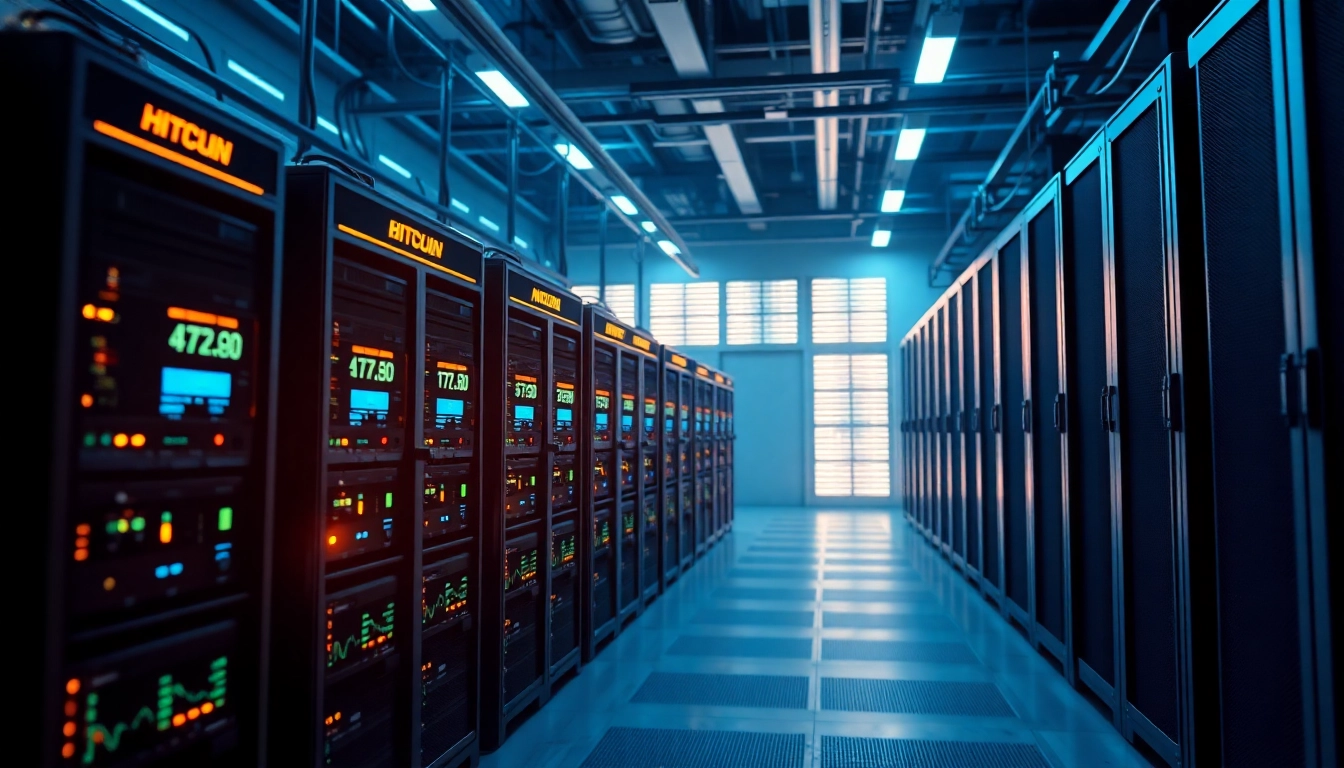Understanding Bitcoin Mining: The Basics
Bitcoin mining is a fascinating and often misunderstood process that serves as the backbone of the Bitcoin network. It involves the validation and addition of transaction records to Bitcoin’s public ledger, known as the blockchain. As we delve into the world of bitcoin mining, we will explore its core concepts, the technology behind it, and how it impacts the entire cryptocurrency ecosystem. To set the stage, let’s clarify some of the fundamental definitions and concepts that underlie this complex operation. For those looking to understand this intricate process, resources like bitcoin mining provide comprehensive insights into its mechanics.
What is Bitcoin Mining?
At its core, bitcoin mining refers to the process of confirming transactions on the Bitcoin network and subsequently adding them to the blockchain. This process is not only essential for transaction verification but also serves as a mechanism for creating new bitcoins. Miners utilize specialized hardware to solve complex mathematical problems that validate transaction blocks. The first miner to solve the problem gets to add the block to the blockchain and is rewarded with newly minted bitcoins, along with transaction fees from the transactions included in that block.
How Bitcoin Transactions Work
Bitcoin transactions are peer-to-peer exchanges made on the Bitcoin network. When a user initiates a transaction, it broadcasts to all the miners and nodes in the network. This transaction must be verified to ensure its legitimacy, which involves confirming that the sender has enough balance to cover the transaction. Miners collect transactions into a block and compete to solve the cryptographic puzzle, which is a part of the proof-of-work mechanism. Once a miner successfully solves the puzzle, the block is added to the blockchain, and the transaction is considered confirmed.
The Role of Miners in Cryptocurrency
Miners play a critical role in maintaining the integrity and security of the Bitcoin network. By solving the cryptographic puzzles, they not only earn bitcoin rewards but also help to secure the network against double-spending attacks. Moreover, miners ensure that transactions are processed efficiently, contributing to the overall functionality of the decentralized ecosystem. Their efforts enable the network to remain operational without the need for a central authority, a foundation principle of cryptocurrency.
Getting Started with Bitcoin Mining
If you’re interested in embarking on your bitcoin mining journey, it’s essential to understand the equipment and infrastructure required to start mining profitably. The mining landscape has evolved significantly, making it crucial to choose the right tools and methods before diving in. Here are some steps to consider.
Choosing the Right Mining Hardware
The first step in setting up a successful mining operation is selecting the appropriate hardware. The two primary types of mining rigs are:
- ASIC Miners: Application-specific integrated circuits (ASICs) are specialized hardware designed specifically for mining cryptocurrencies. They are more efficient than traditional computers and can perform the necessary calculations much faster.
- GPU Miners: Graphics processing units (GPUs) can also be used for mining, particularly in altcoin mining. While not as powerful as ASICs for Bitcoin, they offer flexibility for mining various cryptocurrencies.
Evaluating your budget and mining goals will help determine the best option for you. Keep in mind that hardware prices can fluctuate due to demand and availability.
Setting Up Your Mining Operation
After selecting your hardware, the next step is setting up your mining operation. This involves:
- Configuring Your Hardware: Follow the manufacturer’s instructions to properly assemble and configure your mining rig. Ensure you have adequate cooling systems to prevent hardware damage from overheating.
- Installing Mining Software: Choose compatible mining software that matches your hardware. Popular options include CGMiner, BFGMiner, and EasyMiner. This software connects you to the Bitcoin network and allows your hardware to begin the mining process.
- Joining a Mining Pool or Mining Solo: Deciding between solo mining or joining a mining pool is a significant decision. Solo mining can be rewarding but may take a long time to yield results due to increased competition. Mining pools, on the other hand, combine resources of multiple miners to improve the chances of earning rewards more regularly, sharing profits proportionately.
Joining Mining Pools vs. Solo Mining
Joining a mining pool can be advantageous for newcomers, as it offers a more steady income stream through shared rewards. However, it’s essential to research and choose reputable mining pools that charge lower fees and have good payout structures. Solo mining allows for the full reward when a block is found but comes with the risk of earning zero rewards for extended periods. Ultimately, the choice depends on individual risk tolerance and investment strategy.
Calculating Profitability in Bitcoin Mining
Understanding the profitability of bitcoin mining is essential for anyone considering entering the space. It largely depends on factors such as hardware costs, electricity rates, and the current market price of bitcoin. Here are key considerations for calculating your potential profits.
Evaluating Costs: Hardware and Electricity
Two of the most significant expenses when mining bitcoin are the cost of the mining hardware and electricity fees. High performance ASIC miners can range from hundreds to thousands of dollars, so it’s vital to account for these initial investments. Electricity costs, which vary by location, play a crucial role in your overall profitability. The higher the electricity cost, the lower your potential profits.
Profitability Metrics and Tools
Several online calculators can assist in determining mining profitability. Tools like WhatToMine and NiceHash allow miners to input their hardware specifications and electricity costs to estimate daily earnings. These calculators consider factors like network difficulty and bitcoin price fluctuations, providing valuable insights into whether mining is viable for you.
Market Trends and Their Impact on Earnings
The cryptocurrency market is notoriously volatile, and this volatility directly affects mining profitability. Tracking Bitcoin’s price trends alongside changes in mining difficulty can provide a clearer picture of future earnings potential. Staying informed about market developments is crucial for making timely decisions in the mining landscape.
Challenges Faced by Bitcoin Miners
Despite its promise, bitcoin mining comes with its own set of challenges. Understanding these challenges can help potential miners prepare and strategize effectively.
Common Misconceptions about Mining
Many newcomers to bitcoin mining have misconceptions about the ease of generating profits. The reality is that mining requires significant investment in hardware and operational knowledge. Moreover, as the Bitcoin network has grown, the difficulty of mining has increased, making it more challenging for individual miners to compete effectively.
Regulatory Issues and Environmental Concerns
Bitcoin mining has faced scrutiny over its environmental impact, particularly due to high energy consumption. Various countries are beginning to regulate mining activities to address environmental concerns. Miners should stay informed about regulatory developments in their regions to ensure compliance and to contribute to sustainable practices, potentially leveraging renewable energy sources to power operations.
Technical Challenges and Solutions
The technical challenges in bitcoin mining range from hardware failures to software malfunctions. Staying current with technology updates, investing in robust hardware, and employing diligent maintenance practices can mitigate some of these risks. Additionally, engaging with online communities and forums can provide support and troubleshooting advice.
The Future of Bitcoin Mining: Trends for 2025 and Beyond
As the cryptocurrency landscape evolves, so does the technology and practices surrounding bitcoin mining. Looking ahead, several trends are likely to shape the future of mining.
Emerging Technologies in Mining
Innovations such as more efficient mining hardware, cloud mining solutions, and advanced cooling systems are revolutionizing the sector. These technologies aim to enhance mining efficiency and reduce operational costs, enabling miners to remain competitive in a rapidly evolving market.
Impact of Renewable Energy on Mining
As environmental concerns grow, the reliance on renewable energy sources for mining operations is becoming increasingly prevalent. Miners are seeking sustainable energy solutions such as solar or wind power to reduce their carbon footprint and improve profitability. Utilizing renewable energy not only addresses environmental concerns but can also lead to lower operational costs.
Predictions for Bitcoin’s Market Value
Market experts have varying opinions on Bitcoin’s future value, influenced by factors such as institutional adoption, regulatory news, and technological advancements. While predictions are inherently uncertain, many analysts believe that Bitcoin’s acceptance as a mainstream asset will continue to grow, potentially driving up its value and, consequently, mining profitability.

